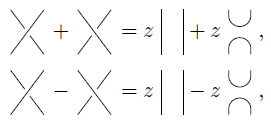Consider the quotient of the monoidal category of framed tangles by one of the two skein relations
together with the twist and dimension relations
Here $1_\mathbb{1}$ denotes the identity morphism of the unit object, i.e. the empty tangle, $z,t$ are invertible elements of a fixed ground ring, and $\delta = 1 - \varepsilon (t+\varepsilon t^{-1})/z$, where $\varepsilon \in \{\pm 1\}$ is the sign appearing in the chosen skein relation.
This yields two variants of the Kauffman skein category. The choice $\varepsilon=1$ leads to the Kauffman polynomial of links, while the choice $\varepsilon=-1$ leads to the Dubrovnik polynomial. Provided the ground ring contains a square root of negative one, these two link polynomials are equivalent (i.e. one can be obtained from the other by rescaling $z,t$ and an overall scaling). More generally, the endomorphism algebras of the two categories are isomorphic after a rescaling of $z,t$, and they are isomorphic to BMW algebras. (See Lemma 8.5 of this paper for the precise statement.) For this reason (I think), the difference between the two skein relations above is often overlooked, and authors choose the one that best suits their needs.
However, one can show that the two categories described above are not isomorphic as monoidal categories, even after rescaling parameters. (See Proposition 8.6 of this paper for a proof.) For the choice of $\varepsilon=-1$, there is a natural functor from the above category to categories of modules for quantized enveloping algebras of type $B,C,D$. I'd like to know if there is a similar action of the category for the choice $\varepsilon=1$. I haven't been able find anything about this in the literature, which surprises me since these categories are fairly well known and well studied.


